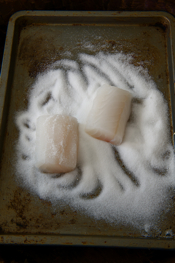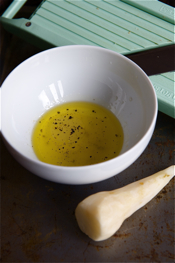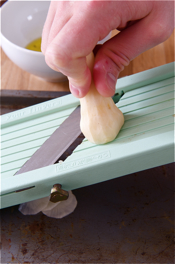This is one of my favourite recipes from one of my favourite websites. I love getting so many textures from using just one ingredient. But for me, the star of the show is the cod. If you've never cured your cod before you're going to love it. It transforms the fish into the most delicate, moist and flaky fish you can get.

Sautéed Cod with Textures of Jerusalem Artichokes
Crisp, crunchy and soft; cold and warm describes the textures of this dish. Cod is a flaky soft but fairly neutral flavoured fish and goes very well with vegetables with a fairly strong identity such as Jerusalem artichokes.
I love the versatility of Jerusalem artichokes but have never attempted to pickle them before. In theory I thought it would definitely not work as the uncooked chokes oxidises and discolours as soon as it’s peeled and sliced. However once mixed with the pickling liquid it was a perfect. I left if for an hour and the crispy thin and slightly acidic slices of Jerusalem artichokes were delicious, truely unique with the distinctive flavour of these chokes.
Well I was pretty pleased, as my dish all of a sudden started to take shape with a good variation of textures. Serving some of the components warm and some cold gives the dish a extra interesting dimension. This dish makes a perfect starter, cutting the fish into 55 – 60g pieces or if you would like to serve it as a main course I suggest cutting the fish to 100g – 120g size portions.
I also lightly cured the cod, the reason being that cod is very flaky and easily fall’s to pieces when cooking, especially if the fish is super fresh. The fish was so fresh it almost smelt like freshly grated lime zest and the colour of the flesh was almost opaque. If the flesh is milky in colour with a slightly yellow tint and a faint ammonia smell then you know it’s not fresh. The cure of salt and sugar only stays on the fish for 10 minutes, you can do this a day in advance. Cure the fish for 10 minutes then wash the cure off, dry the fish and keep it in a clean airtight container in the fridge for the following day. Perfect for a special dinner party.
You can also prepare the pickled Jerusalem artichokes, the choke puree and crisps a day in advance. Keep the crisps in a airtight container to prevent them from going soggy.


